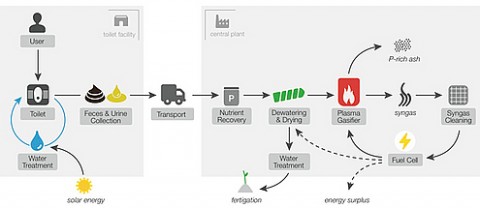This library entry contains background documents for a grant that Paul Janssen is leading and which is funded by the Bill and Melinda Gates Foundation (under the RTTC Round 1 and 2 grant schemes).
Further information and a discussion is available on the SuSanA discussion Forum, see link below.
Title of grant: Upgrade human waste to fuel gas with plasma-driven gasification.
Subtitle: The development of a sanitation system consisting of a microwave plasma gasification mini plant and a human centered design for distributed sanitation facilities in urban informal settlements.
Name of lead organization: Delft University of Technology, Faculty of Mechanical Engineering, Marine Technology and Materials Sciences (3ME) and the Faculty of Industrial Design Engineering (IDE)
Primary contact at lead organization: Paul Janssen
Grantee location: Delft, the Netherlands and field research and testing in Ahmedabad, India
Short description of the project:
A collaboration of two Faculties (3ME and IDE) of Delft University of Technology proposes Microwave Plasma Gasification to generate electricity out of feces. This technology is a combination of the usage of plasma gasification and a solid oxide fuel cell and is an efficient method to get rid of large amounts of feces, meanwhile generating enough electricity to make the system self-supporting. A possible surplus of energy can be used to provide additional services to the community. Other resources that can be recovered out of the collected human waste are nutrients such as phosphate, which is a valuable fertilizer due to the increasing scarcity of its natural reserves. The separated cleansing and flush water can be purified and recycled on site so that it can be reused for hand washing or flushing. Ultimately, this system is a fully stand-alone entity that has no electric utility connection, no (heavy) reliance on piped-in water and no connection to any type of sewerage.
To bridge the gap between this high-end technology and the target group, the Industrial Design engineering team develops a holistic and human centered design sanitation solution for people in urban informal settlements including innovative business models, branding, gender issues and the accompanying product service system.
The proposed concept involves smaller community facilities, each serving 100-500 people per day (5-10 toilets per facility). These facilities are scattered around the slums and operated by local entrepreneurs. Human waste is collected from these facilities and transported to a central Plasma Gasification plant that is located on the outskirts of the slum. At this plant, the human waste of more than 2,000 people can be processed every day. With this concept we aim to demonstrate the potential of a distributed sanitation system that does not rely on a network of sewage pipes but on the empowerment of local collectors and distributors.
The project is split up in four sub-projects and responsible persons:
1. Design of sanitation facility and distribution of feces (Jan Carel Diehl, IDE)
2. Dewatering and drying (Wiebren de Jong, 3ME)
3. Plasma gasification (Georgios Stefanides, 3ME)
4. Gas cleaning and fuell-cell (P.V. Aravind, 3ME)
+++++++++++
Documents available for download below:
1 - Expert convening (summary report, May 2013)
2 - Project Introduction (presentation, May 2013)
3 - Waste & Water Management (presentation, May 2013)
4 - User Experience & Engagement (presentation, May 2013)
5 - Business Model & Branding (presentation, May 2013)
6 - Gasification of human waste via a microwave plasma discharge - Human waste pretreatment-drying selection (poster, May 2013)
7 - Gasification of human waste via a microwave plasma discharge
for SOFCs — gas cleaning, SOFCs and system thermodynamics (poster, May 2013)
8 - Plasma Gasification for Toilet Challenge (poster, May 2013)
Bibliographic information
Janssen, P., Diehl, J. C. (2013).
Upgrade human waste to fuel gas with plasma-driven gasification Various documents on results from research grant Technical University of Delft, Netherlands
Filter / Tags
Fundamental research and engineeringEnglish
External links
Further information on discussion forum
Downloads
1 - Expert convening (Summary report, May 2013)
Download
Type: application/pdf
Size: 2.33 MB
2 - Project Introduction (Presentation, May 2013)
Download
Type: application/pdf
Size: 2.36 MB
3 - Waste & Water Management (Presentation, May 2013)
Download
Type: application/pdf
Size: 2.96 MB
4 - User Experience & Engagement (Presentation, May 2013)
Download
Type: application/pdf
Size: 6.54 MB
5 - Business Model & Branding (Presentation, May 2013)
Download
Type: application/pdf
Size: 2.53 MB
6 - Gasification of human waste via a microwave plasma discharge - Human waste pretreatment-drying selection (Poster, May 2013)
Download
Type: application/pdf
Size: 0.46 MB
7 - Gasification of human waste via a microwave plasma discharge for SOFCs — gas cleaning, SOFCs and system thermodynamics (Poster, May 2013)
Download
Type: application/pdf
Size: 0.57 MB
8 - Plasma Gasification for Toilet Challenge (Poster, May 2013)
Download
Type: application/pdf
Size: 1.23 MB

Published in: 2013
Pages: 0
Publisher:
Technical University of Delft, Netherlands
Author(s):
Janssen, P., Diehl, J. C.
Uploaded by:
TU Delft
Delft University of Technology
Location of library entry:

